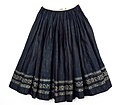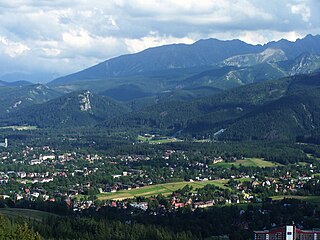
Zakopane is a town in the extreme south of Poland, in the southern part of the Podhale region at the foot of the Tatra Mountains. From 1975 to 1998, it was part of Nowy Sącz Voivodeship; since 1999, it has been part of Lesser Poland Voivodeship. As of 2017 its population was 27,266. Zakopane is a centre of Goral culture and is often referred to as "the winter capital of Poland". It is a popular destination for mountaineering, skiing, and tourism.

Fetish fashion is any style or appearance in the form of a type of clothing or accessory, created to be extreme or provocative in a fetishistic manner. These styles are by definition not worn by the majority of people; if everyone wears an item, it cannot have fetishistic, special nature. They are usually made of materials such as leather, latex or synthetic rubber or plastic, nylon, PVC, spandex, fishnet, and stainless steel. Some fetish fashion items include: stiletto heel shoes and boots, hobble skirts, corsets, collars, full-body latex catsuits, stockings, miniskirt, crotchless underwear, jockstraps, diapers, garters, locks, rings, zippers, eyewear, handcuffs, and stylized costumes based on more traditional outfits, such as wedding dresses that are almost completely see-through lace, or lingerie for men.

1860s fashion in European and European-influenced countries is characterized by extremely full-skirted women's fashions relying on crinolines and hoops and the emergence of "alternative fashions" under the influence of the Artistic Dress movement.

Fashion in the 1890s in European and European-influenced countries is characterized by long elegant lines, tall collars, and the rise of sportswear. It was an era of great dress reforms led by the invention of the drop-frame safety bicycle, which allowed women the opportunity to ride bicycles more comfortably, and therefore, created the need for appropriate clothing.

Podhale is Poland's southernmost region, sometimes referred to as the "Polish Highlands". The Podhale is located in the foothills of the Tatra range of the Carpathian mountains. It is the most famous region of the Goral Lands which are a network of historical regions inhabited by Gorals.
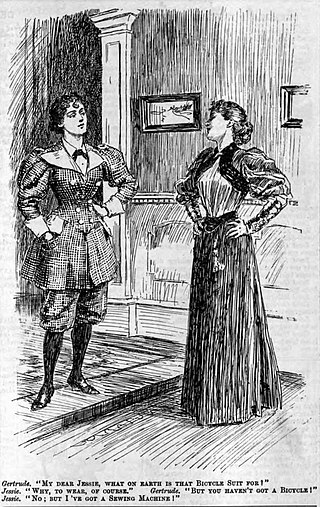
Victorian dress reform was an objective of the Victorian dress reform movement of the middle and late Victorian era, led by various reformers who proposed, designed, and wore clothing considered more practical and comfortable than the fashions of the time.

1850s fashion in Western and Western-influenced clothing is characterized by an increase in the width of women's skirts supported by crinolines or hoops, the mass production of sewing machines, and the beginnings of dress reform. Masculine styles began to originate more in London, while female fashions originated almost exclusively in Paris.

The Gorals, also known as the Highlanders are an indigenous ethnographic or ethnic group primarily found in their traditional area of southern Poland, northern Slovakia and in the region of Cieszyn Silesia in the Czech Republic, where they are known as the Silesian Gorals. There is also a significant Goral diaspora in the area of Bukovina in western Ukraine and in northern Romania, as well as in Chicago, the seat of the Polish Highlanders Alliance of North America.

1880s fashion in the in Western and Western-influenced countries is characterized by the return of the bustle. The long, lean line of the late 1870s was replaced by a full, curvy silhouette with gradually widening shoulders. Fashionable waists were low and tiny below a full, low bust supported by a corset. The Rational Dress Society was founded in 1881 in reaction to the extremes of fashionable corsetry.

Fashion in the period 1795–1820 in European and European-influenced countries saw the final triumph of undress or informal styles over the brocades, lace, periwigs and powder of the earlier 18th century. In the aftermath of the French Revolution, no one wanted to appear to be a member of the French aristocracy, and people began using clothing more as a form of individual expression of the true self than as a pure indication of social status. As a result, the shifts that occurred in fashion at the turn of the 19th century granted the opportunity to present new public identities that also provided insights into their private selves. Katherine Aaslestad indicates how "fashion, embodying new social values, emerged as a key site of confrontation between tradition and change."

Fashion in the period 1900–1909 in the Western world continued the severe, long and elegant lines of the late 1890s. Tall, stiff collars characterize the period, as do women's broad hats and full "Gibson Girl" hairstyles. A new, columnar silhouette introduced by the couturiers of Paris late in the decade signaled the approaching abandonment of the corset as an indispensable garment.

Pakaian is the term for clothing in Malaysia's national language. It is referring to things to wear such as shirts, pants, shoes etc. Since Malaysia is a multicultural nation: Malay, Chinese, Indian and hundreds of other indigenous groups of Malay peninsula and Borneo, each has its own traditional and religious articles of clothing all of which are gender-specific and may be adapted to local influences and conditions. Previously, traditional clothes were worn daily. However, by excluding Baju Melayu, Baju Kurung many are now only worn on special occasions such as marriage ceremonies and cultural events.

Icelandic national costume, collectively known in Icelandic as Þjóðbúningurinn has enjoyed various levels of popularity since the term was coined in Iceland in the 19th century, during the struggle for independence. Since 2001 the national costume is regulated by Þjóðbúningaráð, which preserves the correct techniques of making them and instructs people.

A parzenica is a heart-shaped traditional handicraft pattern and decorative folk art of the Goral people, who live in the mountainous region of southern Poland. It is often found embroidered on the upper front side of men's trousers.

Zakopane Style is an art style, most visible in architecture, but also found in furniture and related objects, inspired by the regional art of Poland's highland regions, most notably Podhale. Drawing on the motifs and traditions in the buildings of the Carpathian Mountains, this synthesis was created by Stanisław Witkiewicz who was born in the Lithuanian village of Pašiaušė, and is now considered to be one of the core traditions of the Goral people.

National costumes of Poland vary by region. They are not worn in daily life but at folk festivals, folk weddings, religious holidays, harvest festivals and other special occasions. The costumes may reflect region and sometimes social or marital status.
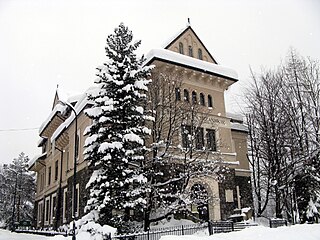
The Tatra Museum is a museum of the history, culture, nature and ethnography of the Polish Tatras; its main branch is located in Zakopane, Poland.

The Museum of Zakopane Style at Villa Koliba is a division of the Tatra Museum in Zakopane, and a museum of Zakopane style.
Clothing in Myanmar varies depending on the ethnicity, geography, climate and cultural traditions of the people of each region of Myanmar (Burma). The most widely recognized Burmese national costume is the longyi, which is worn by both males and females nationwide. Burmese clothing also features great diversity in terms of textiles, weaves, fibers, colours and materials, including velvet, silk, lace, muslin, and cotton.
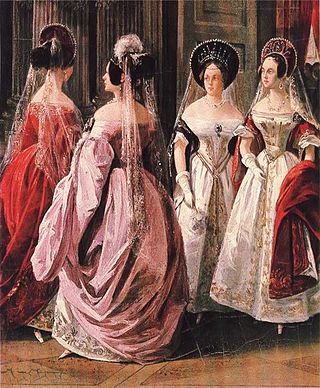
Russian court dress was a special regulated style of clothing that aristocrats and courtiers at the Russian imperial court in the 19th-20th centuries had to follow. Clothing regulations for courtiers and those invited to the court are typical for most European monarchies, from the 17th century to the present. In Russia, court etiquette and, accordingly, court dress ceased to exist in 1917 due to the abolition of the monarchy.







